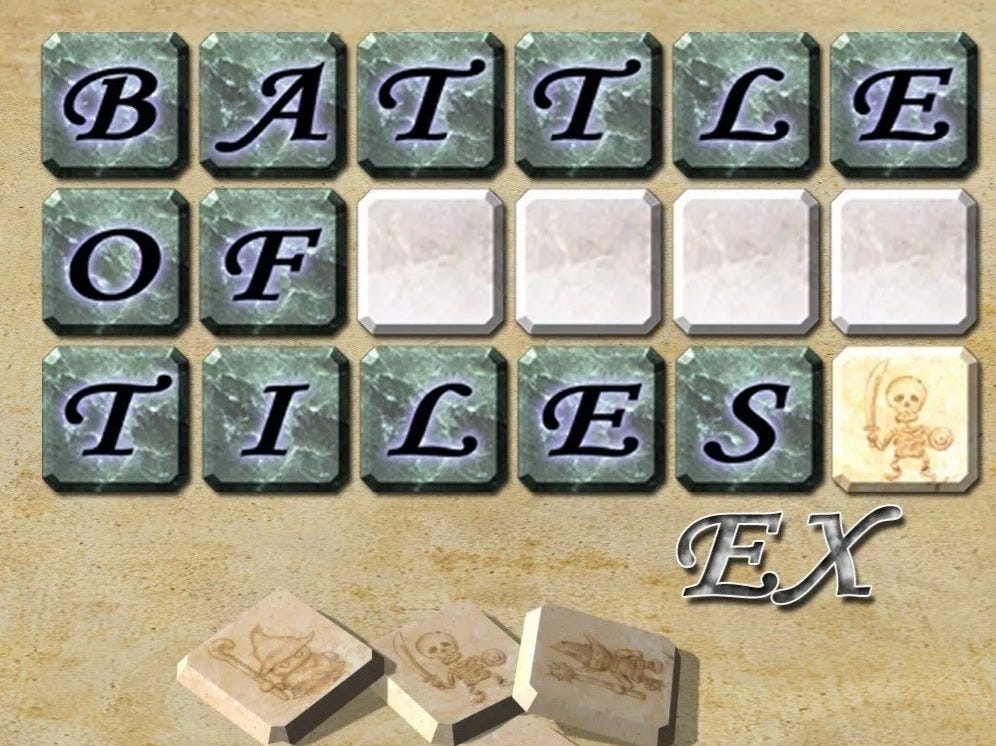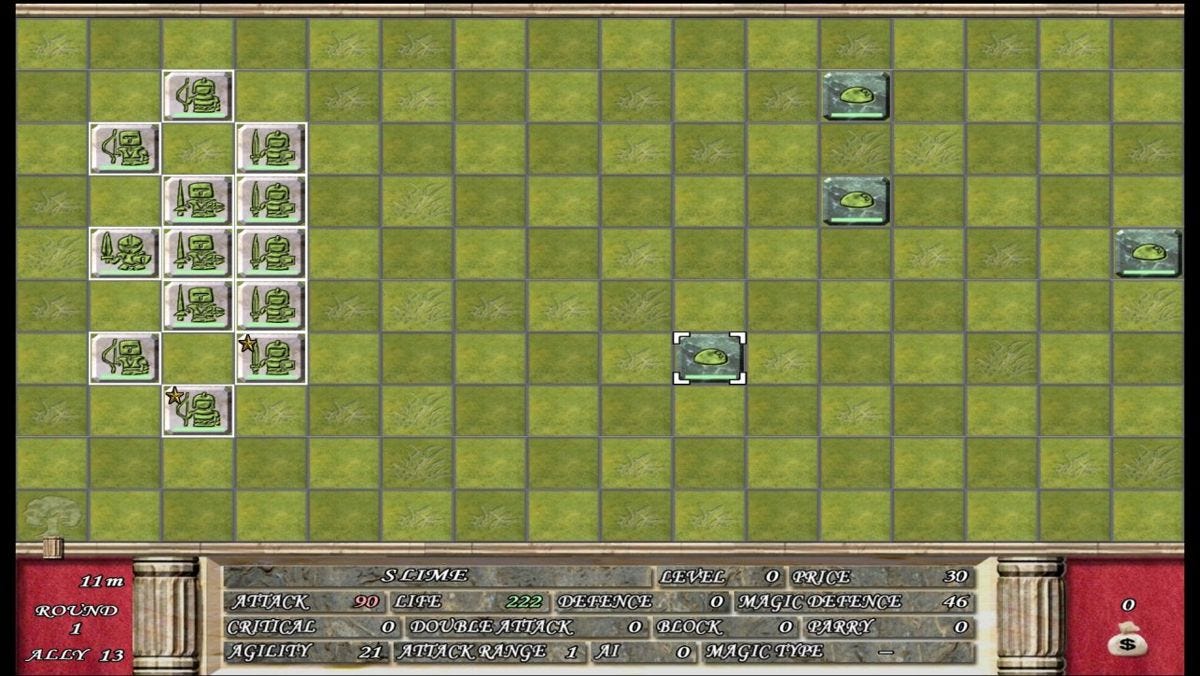Battle of Tiles Ex, Hattori's side-scrolling tactical gauntlet
Developer: Bimboosoft
Publisher: Bimboosoft
Director: Hirofumi Hattori
Genre: Tactical JRPG with side-scrolling maps featuring large formations of different tiles, acting as an army with a variety of units
Progression: literally linear
Country: Japan
Platform: PC, Android, PS3
Release date: 2008 (PC) 8\10\2013 (PS3, PSN-only release)
Completed on: 11\11\2013
The early ‘10s were a pivotal time for indie (or doujin, as self-made projects across media are called there) Japanese RPGs on PC, with a few early localizations, such as Carpe Fulgur’s Recettear and Fortune Summoners, showing how there was indeed a Western audience for that kind of titles on Steam, which in turn led to more and more JRPGs being published on that platform by other companies, at first smaller publishers like XSEED with their Falcom lineup and NISA with Cladun X2, but then also Square Enix, Namco and Sega, opening up a new revenue stream that, by the end of the decade, no one even dared to question.
Of course, while a number of those early indie Japanese localizations ended up being success stories, with Recettear selling around 300k copies after a few years, many others ended up mostly forgotten even inside their own niche, including a number of interesting efforts that mixed a shoestring budget with imaginative design choices.

One of those games was Battle of Tiles by Bimboosoft, a company based in the Saitama prefecture that mostly worked on tennis and rollercoaster simulators, including a Virtual Reality outing on PS4 later on. Bimboosoft’s founder (and possibly only employee), Hirofumi Hattori, who previously worked at Banpresto, seems to have chosen the name for his company while inspired by the Japanese word “binbou”, meaning poverty, which immediately made him endearing to me.
Battle of Tiles, his first (and only, so far) contribution to the broader Japanese RPG scene, started out as a PC release back in 2008, possibly foregoing the usual Comiket distribution most doujin games focused on due to its rather peculiar nature, but was later updated to the Ex verion and ported first on iOS and Android and then, finally, on PS3 in 2013, where it ended up being one of the very few digital-only localized JRPGs alongside NIS-published Legasista and Battle Princess of Arcadias or XSEED’s Wizardry: Labyrinth of Lost Souls.
Battle of Tiles EX betrays its mid ‘00s indie roots and arcade elements by the total absence of a narrative framework: once the player chooses a difficulty level, they will find themselves thrown into a horizontally side-scrolling grid map, with a small army of tiles corresponding to King Arthur and his armigers, each one with their own statistics, class and skills. If the incipit is abrupt enough, the player won’t really have time to think about the lack of character development or story events, considering the game’s unique side-scrolling tactics quickly becomes an addicting affair, helped out by a soundtrack heavily inspired by 16bit-era JRPG tunes.
Its gameplay loop, itself quite simple, consists in moving all the allied tiles forward at once, slowly progressing to the right side of each level while grinding meters and squares (the distance already covered by your army is also tracked on the screen, almost like if this was a running game) and, after defeating hordes of enemies, tackle the resident boss, allowing the army to move on to a new area.
Hattori’s effort subtly takes a page from the roguelike playbook, which back then was far less popular than nowadays, with each square conquered by the King’s army immediately triggering an enemy action, rather than having proper unit-specific activations like in most tactical JRPGs. When enemy units come into contact, combat will ensue by triggering all the relevant damage, healing and magical effects, in a quick turn-based skirmish that, again, blends turn-based tactical action with an arcade feel.
While up to this point Battle of Tiles’ gameplay loop may seems very simple and straightforward, progressing in its scenarios requires to make use of other, more complex and initially less immediate strategies, such as moving single units or small groups of tiles in order to bait enemy units, or passing turns without moving and reorganizing the army’s overall formation, which will soon come to include dozens of units that need to be carefully managed in order to maximize the effectiveness of individual tiles depending on their position, with tanks useful for absorbing damage in the front line, archers with their ranged attacks, mages with their area of effect skills, healers and even rear units, useful in the case of surprise attacks by enemy reinforcements that will sometimes appear right behind our troops.
While part of each unit’s HPs is cured each turn and there is no shortage of healers to help out wounded tiles, losing a few soldiers when facing enemy hordes or lethal boss attacks will prove inevitable, making it mandatory to replenish the King’s army by spending the money obtained in combat in order to recruit the most promising tiles deployed by the AI, paying attention to their type (humans tend to be divided into traditional RPG classes, but there are also plenty of monsters with their own properties), their stats and their starting level. Indeed, in many cases, enlisting an inexperienced unit can be advantageous because of its low cost, as the whole army gets experience points by defeating enemies allowing weaker allies to grow stronger rather quickly.
This set of systems, coupled with the unexpected length of its levels, ends up making Battle of Tiles EX's individual playthroughs more tense than one could initially envision, and its challenge does not end once the final boss is beaten: following an old tradition common to both arcade titles and JRPGs, Bimboosoft’s game allows you to immediately switch to a second loop, or New Game+ by restarting the game with your final formation, which will obviously lead to confronting significantly stronger enemies. The higher challenge also nets the King more money for the royal army’s budget, making it possible to recruit incredibly costly units like the Gargoyles, creatures so powerful the player could very well choose to change the army’s formation just to avoid facing them and see their frontline tiles decimated.
If this peculiar mix of tactical depth and fast side-scrolling action made Battle of Tiles EX fairly addicting, at times almost hypnotic, in the long run some of its issues became more obvious, like with the small number of stages, or with their length compared with the variety they’re actually able to provide. Its stylized art direction, betraying the game’s low production values, almost felt like an adaptation of a non-existent board game (a choice shared by Imai’s Tokyo Twilight Ghost Hunters just a few years later), and likely played a role in making most people interested in tactical JRPGs overlook Bimboosoft’s title, although this kind of presentation is actually apt at providing a clear, readable view of the battlefield.
Back when I completed it in 2013, I felt that Battle of Tiles EX was a game made for a small niche, but that its uniqueness and the increasing complexity of its challenge still made it an interesting experience for those willing to give a chance to a low budget Japanese indie game with no marketing whatsoever, which unfortunately likely amounted to very few people.
Looking back at Battle of Tiles, one can’t shake the impression that its unique gameplay formula could have been much more successful if it had been released a few years later, with a wider audience interested in indie titles compared to its late ‘00 PC release or its muted 2013 PS3 port, possibly expanding it in order to make its loop more varied, for instance introducing some sort of roguelike feature in terms of map design and tiles spawn in order to increase the game’s variety and challenge.
Still, more than a decade after its English release, there’s still nothing quite like it (Metal Slug Tactics did briefly remind me of Battle of Tiles Ex on a purely conceptual level, but this risks being a forced comparison given how incredibly different they’re in pretty much every way) , and it’s regrettable Hirofumi Hattori didn’t have a chance to build on his first tactical effort and that Battle of Tiles EX didn’t share the luck of another doujin side-scrolling JRPG, roguelike One Way Heroics, in getting a remake that could make it appealing to a broader audience while also preserving it on more accessible platforms.






